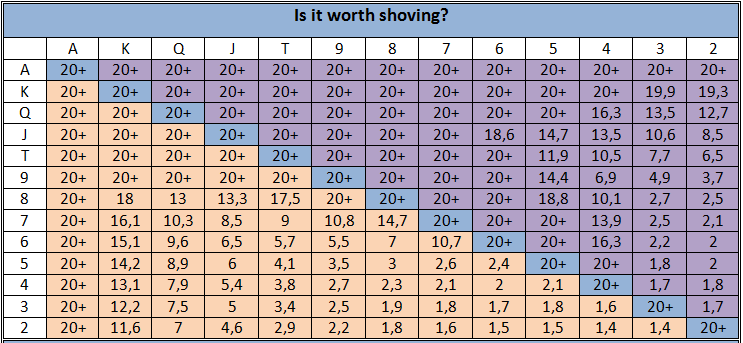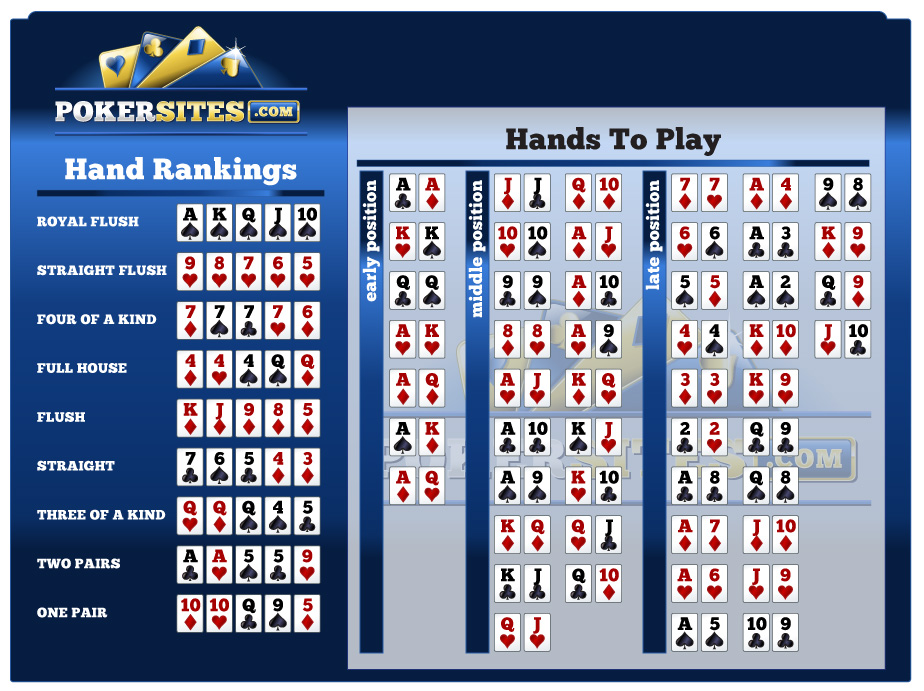Pot Odds Cheat Sheet. When you're on a draw and your opponent bets, you need to check your pot odds to make sure you are getting the right price to call. Otherwise, you risk making a losing play. This cheat sheet shows you the pot odds and equity required to call for the most common bet sizes. EV = (.47. $13) – (.53. $11) = 6.11 – 5.83 = +$0.28 If we look at our two options here, between calling and folding, a fold would be 0EV because we don’t make or lose anythingand a call would be +EV to the tune of $0.28. Click on any card to highlight it. Follow these hand charts and learn how to play your starting hands at Texas Holdem. The charts below will give you a great starting point on how to play your starting hands. For all of you beginners, we recommend consulting these charts will playing online. We provide 4 separate charts depending on where you are seated relative to the dealer. Get Your Miniature (Credit Card Sized) Texas Holdem Starting Hands Cheat Sheet; Poker Odds Cheat Sheet (for Texas Hold’em) How To Use This Pot Odds Cheat Sheet – Facing River Bet Example. Work out pot odds; 2. Find 2.6:1 on the card (or as close to it as possible). Determine our actual equity; 4. Determine if we can profitably call. Check out our hand ranking cheat sheet, with which you will never doubt your hand strength. Odds and outs To explain odds and outs in a simple manner i tell you this: In poker, you have around 2% equity (chance of winning after the river) for every out you have.
Once the flop has been dealt in Texas Hold'em, you'll be able to count your outs and know how likely it is your hand will improve. That will tell you whether you should stay in the hand or fold.
You can figure out your outs and odds for any hand, but here is a quick and dirty list of the most common scenarios:
Texas Hold'em Cheat SheetOdds Based on Outs after the Flop
If after the flop, you have:
Two outs: Your odds are 11 to 1 (about 8.5 percent)
A common scenario would be when you have a pair and you are hoping your pair becomes a three-of-a-kind (a set).
Four outs: Your odds are 5 to 1 (about 16.5 percent)
A common scenario would be when you are trying to hit an inside straight draw (there are 4 cards of one number that will complete the straight) or you have two pairs and you hope to make a full house (there are three cards remaining of one number and two of the other).
Eight outs: Your odds are 2 to 1 (about 31 percent)
A common scenario would be that you have an open-ended straight draw. There are four remaining cards of two different numbers that will complete your straight, on the high end and on the low end.
Nine outs: Your odds are 2 to 1 (about 35 percent)
This is the common scenario when you have a flush draw. Any of the nine remaining cards of the suit will give you a flush.
Fifteen outs: Your odds are 1 to 1 (about 54 percent)
A scenario for this is having a straight and flush draw, where either any of the nine remaining cards of the suit will give you a flush, while there are four cards remaining of each of two numbers that would complete a straight. However, you don't count the same cards twice as outs, so those of suit you hope to get don't count again.

Poker Odds Hand Strength Calculator Excel Sheets
The Rule of Four and Two
These odds only apply to counting both the turn and the river, so they assume you will stay in the hand until the showdown. Your odds are only about half as good for a single card draw, such taking the hit on the turn or taking the hit on the river. A common way of looking at the difference in the odds when you will be seeing two cards compared with one is called the Rule of 4 and 2.
After the flop, count your outs and multiply them by four to get your percentage odds. This doesn't give you an exact number, but it is quickly in the ballpark. With 15 outs, 4 x 15 = 55 percent you'll complete that straight or flush with the next two draws.

Poker Odds Hand Strength Calculator Excel Sheet Calculator
However, when you are calculating the odds that a single draw will improve your hand, you multiply the outs by two rather than 4. With 15 outs, 2 x 15 = 30 percent chance.